plains cottonwood
(Populus deltoides ssp. molinifera)
Conservation • Wetland • Description • Habitat • Ecology • Use • Distribution • Taxonomy
Description |
||
Plains cottonwood is a large hardwood tree. It is the most massive tree in Minnesota. Mature trees in the state are usually 60′ to 80′ tall and up to 36″ in diameter at breast height. Large individuals can reach over 130′ in height. It is fast growing, in fact the fastest growing tree in North America, growing 6′ to 12′ per year under favorable conditions. It is short lived, commonly lasting only 50 years. In favorable conditions it may last 80 to 90 years. Older individuals can survive up to 200 years. It rises on a single stem from a shallow, wide-spreading root system. It rarely produces suckers. In the open the trunk is short and massive. It often splits near the ground into a two or more widely-spreading stems, creating an open, broad, irregular crown. In a forest the trunk is long and straight and the crown is small and rounded. The bark on young trees is smooth and yellowish-gray. As it ages it becomes thick, ashy gray to brown, and deeply furrowed, with whitish troughs and long, angular ridges. The twigs are stout, smooth, hairless and light yellow or yellowish-brown with pale dots (lenticels). They are angular in cross section with narrow ridges extending down from each side of the bud. Terminal buds are yellowish-brown, hairless, and sticky (resinous). They are ⅜″ to ¾″ long, slender, and 3-sided. They are widest at the middle, tapering slightly to the base and tapering to a long point at the tip. They are not aromatic. Lateral buds are similar but smaller, and diverge from the twig. The leaf scars are large, triangular, and 3-lobed, with 3 large bundle scars and eyelash-like hairs where the bud meets the scar. The leaves are deciduous, alternate, thick, firm, and not lobed or divided (simple). They are triangle-shaped, 2″ to 4″ long and 2¼″ to 4⅓″ wide. They hang downward on yellowish, flattened, 1½″ to 3⅛″ long leaf stalks. The blades taper at the tip to a long point with concave sides along the tip. They are straight across (truncate) or almost straight across at the base. The upper surface is bright green, shiny or waxy, and hairless. The lower surface is similar but slightly paler green. The margins are coarsely toothed with 5 to 15 teeth per side. The teeth are rounded, forward pointing, and distinctly curved. There are no teeth along the tip or near the leaf stalk. There are usually 1 or 2 warty glands where the leaf blade attaches to the stalk. In autumn the leaves turn yellow to yellowish-orange. Leaves on suckers are similar but often larger. Male and female flowers are borne on separate plants. They appear before the leaves in early April to early May. Both male and female flowers are borne in crowded, pendulous, short-stalked or almost stalkless catkins on 2nd year branchlets. Male catkins are 2″ to 4¾″ long, stout, reddish, and densely flowered. Female catkins are 2⅜″ to 4¾″ long, slender, greenish-yellow, and few-flowered. Female catkins elongate when fruiting, becoming 3½″ to 6¾″ long. The fruit is an egg-shaped, ¼″ to 7 ⁄16″ long, 3- or 4-valved capsule. Each capsule contains numerous seeds. The seeds are released late mid-May to early mid-June. They have cottony hairs attached and are dispersed by wind. |
||
Height |
||
60′ to 80′ |
||
Record |
||
The champion plains cottonwood in Minnesota is on public property near Watson, in Chippewa County. In 2001 it was measured at 106′ tall and 394″ in circumference (125½″ in diameter). |
||
Flower Color |
||
Reddish or greenish-yellow |
||
Similar Species |
||
| Eastern cottonwood (Populus deltoides ssp. deltoides) leaves have 20 to 25 teeth per side and 3 to 5 basal glands. It does not occur in Minnesota. | ||
Habitat |
||
Floodplains, along streams and lake shores. Full sun. |
||
Ecology |
||
Flowering |
||
March to May |
||
Intergrades |
||
Wherever the range of Populus deltoides ssp. deltoides approaches that of another subspecies, the trees intergrade readily. In the Great Lakes region, this area includes eastern Iowa, southwestern Wisconsin, and possibly Houston County in southeastern Minnesota. |
||
Pests and Diseases |
||
Pemphigus populicaulis is an aphid that causes a gall at the junction of leaf blade and petiole. The opening in the gall is a slit running parallel to the direction of the petiole. Poplar petiolegall aphid (Pemphigus populitransversus) is an aphid that forms a gall near the middle of a leaf petiole. The opening in the gall is a slanted, sideways slit. |
||
Use |
||
|
||
Distribution |
||||
|
Sources |
|||
| 6/16/2022 | ||||
Nativity |
||||
Native |
||||
Occurrence |
||||
Very common |
||||
Taxonomy |
|||
| Kingdom | Plantae (Plants) | ||
| Division | Tracheophyta (Vascular Plants) | ||
| Subdivision | Spermatophytina (Seed Plants) | ||
| Class | Magnoliopsida (Dicots) | ||
Order |
Malpighiales (Nances, Willows, and Allies) | ||
Family |
Salicaceae (Willow) | ||
| Subfamily | Salicoideae | ||
| Tribe | Saliceae | ||
| Genus | Populus (poplars, cottonwoods, and aspens) | ||
| Section | Aigeiros | ||
| Species | Populus deltoides (eastern cottonwood) | ||
Synonyms |
|||
Monilistus monilifera Populus besseyana Populus deltoides var. occidentalis Populus monilifera Populus occidentalis Populus sargentii Populus sargentii var. texana Populus texana |
|||
Common Names |
|||
plains cottonwood plains poplar river cottonwood Texas cottonwood western cottonwood |
|||
Glossary
Catkin
A slim, cylindrical, drooping cluster of many flowers. The flowers have no petals and are either male or female but not both.
Lenticel
A corky, round or stripe-like, usually raised, pore-like opening in bark that allows for gas exchange.
Simple leaf
A leaf that is not divided into leaflets, though it may be deeply lobed or cleft.
Intergrade vs. Hybrid
The term “hybrid” is used to describe the offspring of parents of two different varieties, subspecies, species, or genera. In practice, the term “intergrade” is used only to describe the offspring of parents of different subspecies or varieties.
Visitor Photos |
|||||
Share your photo of this plant. |
|||||
| This button not working for you? Simply email us at info@MinnesotaSeasons.com. Attach one or more photos and, if you like, a caption. |
|||||
Alfredo Colon |
|||||
Maybe I have said this before, but most of my photos show thin white 'strings' entangled with the insects. These are the product of a seed found everywhere in Woodbury, MN. You can also see them flying in the wind everywhere. |
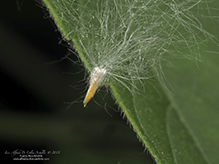 |
||||
They usually lined the trails I followed. Sorry I don't know the name of the tree. |
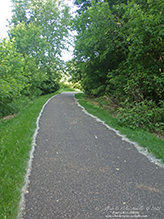 |
||||
Dan W. Andree |
|||||
Big Cottonwood Tree... I came across it in the woods along the Wild Rice River, Mn. I jokingly said to myself…looks like it is trying to grow a nose…😊 Awesome big tree and it was healthy all the way up. |
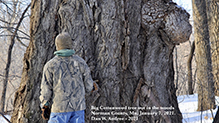 |
||||
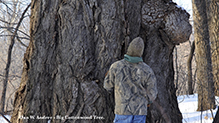 |
|||||
Randy |
|||||
Enormous plains cottonwood just beginning to turn |
|||||
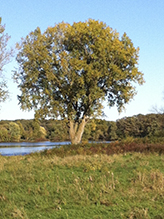 |
|||||
Cluster of towering cottonwoods in Albert Lea |
|||||
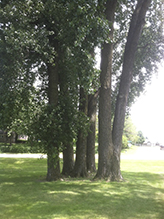 |
|||||
Cottonwood releasing seed |
|||||
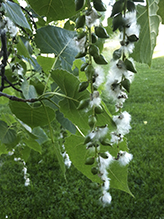 |
|||||
MinnesotaSeasons.com Photos |
|||||
Tree |
|||||
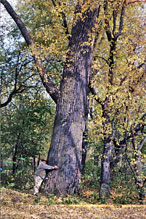 |
|||||
Female Inflorescence |
|||||
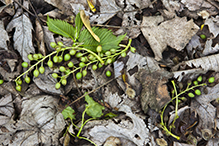 |
|||||

Slideshows |
||
| Populus deltoides Blake C. Willson |
||
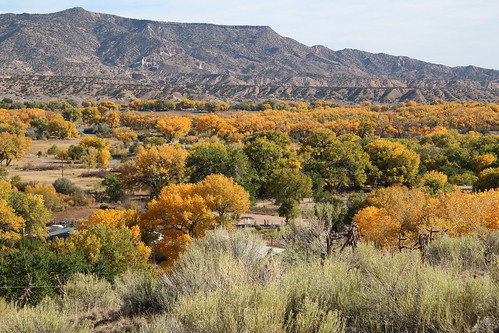
|
||
| Populus deltoides Matt Lavin |
||
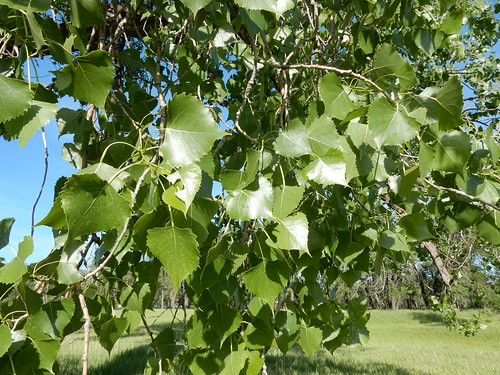
|
||
About
Native tree 20-30 m tall, petiole laterally flattened and the broad leaf blade usually with a truncate or cordate base, along riparian corridors throughout much of Montana at lower elevations. A related species you should know includes the Lombardy or Italian poplar, Populus nigra, an introduced tree with leaves similar to those of Populus deltoides (e.g., laterally flattened petiole) but with distinctly ascending branches resulting in a columnar canopy and with leaves that are more triangular in shape usually without the hastate or truncate base. |
||
| American Cottonwood Andree Reno Sanborn |
||

|
||
About
Populus deltoides |
||

Visitor Videos |
|||
Share your video of this plant. |
|||
| This button not working for you? Simply email us at info@MinnesotaSeasons.com. Attach a video, a YouTube link, or a cloud storage link. |
|||
Other Videos |
|||
| Trees with Don Leopold - eastern cottonwood ESFNature |
|||
About
Published on Dec 18, 2013 Don Leopold demonstrates the characteristics of eastern cottonwood. Content produced by Christopher Baycura for the SUNY College of Environmental Science and Forestry (SUNY-ESF). |
|||
| Eastern Cottonwood Tree Identification MiWilderness |
|||
About
Published on Mar 27, 2012 More tree videos: http://www.youtube.com/playlist?list=PL69BBBB171107F34B Eastern cottonwood is a tree with many uses. The bark is good for carving floats and bobbers for fishing. The edible late winter buds are good medicine for colds, pain, fever, sprains and the like, balm of gilead. The dry inner bark fibers make excellent tinder for fire prep. |
|||
| Eastern Cottonwood Seeds (Salicaceae: Populus deltoides) Drift like Snow Carl Barrentine |
|||
About
Published on Jun 1, 2012 Photographed at the Turtle River State Park, North Dakota (31 May 2012). |
|||

Visitor Sightings |
|||||
Report a sighting of this plant. |
|||||
| This button not working for you? Simply email us at info@MinnesotaSeasons.com. Be sure to include a location. |
|||||
| Alfredo Colon 6/2/2021 |
Location: Woodbury, MN Maybe I have said this before, but most of my photos show thin white "strings" entangled with the insects. These are the product of a seed found everywhere in Woodbury, MN. You can also see them flying in the wind everywhere. They usually lined the trails I followed. Sorry I don't know the name of the tree. |
 |
|||
| Dan W. Andree 1/7/2021 |
Location: Norman County, Mn. I came across it in the woods along the Wild Rice River, Mn. I jokingly said to myself…looks like it is trying to grow a nose…😊 Awesome big tree and it was healthy all the way up. |
 |
|||
| Cheri 6/11/2017 |
Location: Lake Sylvia boat landing, North of Melrose Awesome tree near the lake. Other giants of different species in nearby woods. |
||||
| Randy October 2016 |
Location: Freeborn County, MN Enormous plains cottonwood just beginning to turn |
 |
|||
| Randy 7/19/2016 |
Location: Albert Lea, MN Cluster of towering cottonwoods in Albert Lea |
 |
|||
MinnesotaSeasons.com Sightings |
|||||
Avon Hills Forest SNA, North Unit Beaver Creek Valley State Park Bertram Chain of Lakes Regional Park Cannon River Turtle Preserve SNA Carpenter St. Croix Valley Nature Center Clifton E. French Regional Park Felton Prairie SNA, Bicentennial Unit Felton Prairie SNA, Shrike Unit Hardscrabble Woods / MG Tusler Sanctuary John Peter Hoffman Spring Brook Valley WMA Kellogg Weaver Dunes SNA, Weaver Dunes Unit Mary Schmidt Crawford Woods SNA Minnesota Valley NWR, Black Dog Unit Minnesota Valley NWR, Chaska Unit Minnesota Valley NWR, Long Meadow Lake Unit Minnesota Valley NWR, Louisville Swamp Unit Minnesota Valley NWR, Rapids Lake Unit Minnesota Valley NWR, Wilkie Unit Minnesota Valley State Recreation Area, Lawrence Unit Mound Spring Prairie SNA, North Unit Nerstrand Big Woods State Park Northern Tallgrass Prairie NWR, Touch the Sky Prairie Unit P.N. and G.M. Nelson Wildlife Sanctuary Pankratz Memorial Prairie, North Unit Pembina Trail Preserve SNA, Crookston Prairie Unit Robert Ney Memorial Park Reserve Sand Prairie Wildlife Management and Environmental Education Area |
|||||

|
Created: Last Updated: © MinnesotaSeasons.com. All rights reserved. |
